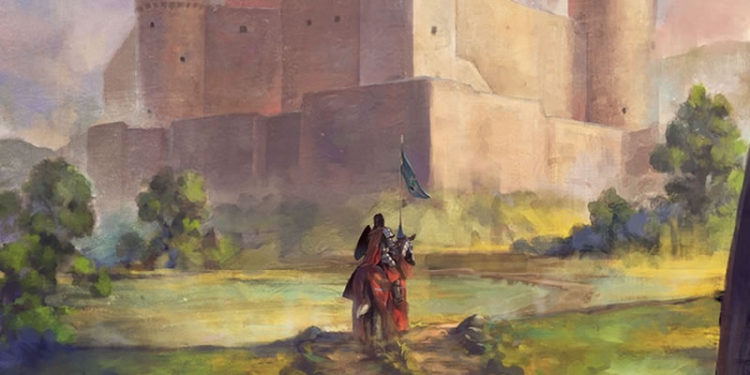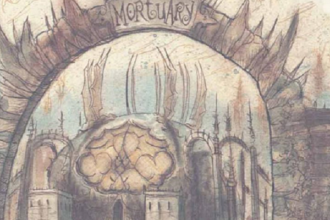Strongholds & Followers Breakdown, Part One

A few months back, I got my hard copy of Matt Colville’s Strongholds & Followers, the product of MCDM’s explosively successful Kickstarter. If you’ve been reading my work in Tribality for the last few years, you’ll understand that I jumped on this KS, and that now I’m going to write something that is half review and half design analysis. All things are ready, if our minds be so!
The Fundamentals
Now, this book only promises what it says right there in the title – you’re building your character’s or team’s stronghold, attracting followers, and doing things with that. It’s not centered on conquering a vast kingdom or empire-building. It sounds like it’s going for a mixed focus between politics, military campaigning, and traditional squad-sized character action. It does this by making sure the large-scale content still feeds back into personal-scale content (character features), using a particularly Birthright-friendly justification: you’re empowered by the land itself.
There are four kinds of strongholds, the keep (warrior types), tower (arcane), temple (divine), and “establishment” (not just legal… extra-legal). A fifth stronghold type, the castle, is the combination of any two or more other strongholds. (A castle without a keep is a bit of a misnomer, but possible in S&F.) Each character class has a unique interaction with their stronghold as well, but I’ll get to that in a minute.
Once you build a stronghold, you can also level it up. Unlike some of the stronghold rules I studied in the Domain Rulership series, there are no floor plans or trap placement here. Strongholds range from level 1 to level 5, costing rather princely sums to advance. New levels grant the stronghold greater Size (hit points) and Toughness (resistance to harm) and grant their owner additional uses of bonus class features.
It’s Matt Colville, so you’ve got to know going in that there’s extensive marginalia and commentary. No matter how good the book turns out to be, that’s going to be the best part: even if you happen to disagree, he presents his positions well. His examination of elements like construction time (shorten it so the project gets done within the span of the campaign!), making it rain coinage early enough in the campaign to get PCs into this part of the game, and how to factor in cleared-out dungeons are all good reads, even if you decide to go for a different stronghold system.
The Keep
This section contains some rules on attracting or hiring, then maintaining, military units (hur hur, I said units). The details of those come much later in this book, and I’ll get to them in a later article. It’s here that we first learn that units have a Size just like strongholds do. Size is a die value – d4/d6/d8/d12/d20. Keeps reduce the hiring cost (that is, for units that don’t join you spontaneously) and upkeep cost of units by 10% per stronghold level.
Building a keep grants you some units, which are randomly generated on a d100 table. They range from green light infantry to seasoned light cavalry (not granting seasoned heavy cavalry is probably Just Fine). This may also trigger a roll, at the GM’s option, on your class’s followers list, which includes units, retainers, specialists, and more unusual creatures: your few, your happy few, your band of brothers.
Your keep is also a training ground, so you get to pick one training benefit from a list of 10, granting it to yourself and your troops. These benefits are nice to have, though they get into conditional stuff that 5e mostly avoids tracking. Piercing Training, for example, grants +1d6 damage against creatures wearing heavy armor. Caring about your target’s armor type is generally not a thing, with an exception for heat metal.
I’m going to call out Finesse Training as just obscenely good – it’s the 14th level Berserker barbarian feature, but with a weapon type restriction that makes it better for rogues. The book mostly doesn’t expect rogues to build keeps, but that feature alone might turn a rogue’s head. (This book is not a good fit for the serious optimizer in your gaming group, in my very biased view.)
This section has unique handling for a Barbarian Camp – functionally a keep that can pull up stakes and move one or more provinces per season. Several of the rules here plug into Kingdoms & Warfare, a forthcoming book from MCDM. Making some informed guesses about what these rules mean, I love the story aspects of a nomadic warlord’s camp that these rules attempt to model.
Finally, there’s a gorgeous two-page art spread with a sidebar explaining pirate ships as variant “keeps.” It runs a bit counter to earlier comments on how keeps can’t really be secretive. The rules here look good to me. Without more detail on hexes, provinces, and expected army sizes, we can only piece out its imperfections with our thoughts.
The Tower
For spellcasters, there are Towers. Building a tower opens the door to battle magic – something that we have to wait for Kingdoms & Warfare to see, but presumably it’s magic scaled up for mass combat. It also lets you try your hand at spell research. For a spell research system, I stand like a greyhound at the slips, straining at the start.
The system that is here is lightweight in getting from the start of the project to the end of the project: fast-forward the timeline 4 weeks + 1 week per level of the spell – the stronghold’s level. I’m disappointed that any interruption of even a day (other than one day of rest each week) forces you to start over from scratch. I feel that that kind of thing makes the DM and/or other players sort of jerks if they try to do anything else that involves conflict. I have the same problem with 3.x magic item crafting: I see the hurdle it creates, but no benefit that it grants.
The text suggests that it’s equally reasonable for the player to roll for an effect on the several tables of spell effects, or for the GM to choose something that seems appropriate. Steering players away from some of the more cumbersome results is a good enough reason to, let’s say, massage the outcome. In exchange for the effort of building a tower and researching the spell, you get to cast the spell using a slot of one level higher, adding an effect that might be worth about one spell level (Oracular, Fated, Wounding) or wildly better (Regenerating, Invulnerable, Unholy). Those latter examples are sufficiently egregious as to make me unwilling to recommend the subsystem, unless you’re willing to rewrite the benefits on your own.
Now, in fairness, the book is repeatedly very clear that it intends, from first principles, to unbalance your game. To put that another way, the reward that players get for pouring their filthy lucre into these money-pits (uh, is it too obvious that I am a homeowner?) is that they’re considerably more effective (if not more durable) than their level implies. Just be aware of that, and bring out bigger guns earlier.
There’s an alternate stronghold benefit, for those GMs or players who don’t go for spell research. Towers could be aligned to the Eight Traditions (sorry, Bladesingers and War wizards), letting you cast spells of the tower’s Tradition as if you spent a slot one level higher. This only lasts for one spell preparation per level of the tower, which is some strong pressure against taking a lot of long rests. The danger that this presents to game balance is comparatively trivial. From the player’s side, it’s obviously much easier to make good decisions and not worry about bad luck or trap choices.
The Temple
Temples, as I’ve said, are for divine casters. The text points warlocks toward towers, but I think they’re at least as at home in temples; Conjurer wizards might be as well, depending. My point is that beyond unlocking battle magic for its owner, temples also help you summon assistance, using a new statistic called Concordance. In principle, you could try this anywhere, but it sure helps to have a temple. It’s how happy the god of your temple is with you, and so how likely they are to do something helpful. As the text calls out, it’s a lesser Divine Inspiration, with a more nailed-down set of benefits.
When you try to summon something, you roll d100 on a table, adding your Concordance score, plus an extra 30 if you have a temple stronghold of any level. That +30 for having a temple makes it significantly hard to roll the table’s worst result, so you really want one of those. On a good roll, you get a servitor creature for 4 rounds + the temple’s level. The roll determines the strength of the servitor, while your temple’s cosmic alignment (one of seven different factions) determines the flavor.
Insofar as I have any issue with this subsystem, it’s with the table of bonuses and penalties to your Concordance. They (seem to) assume a world in which faiths and cosmic factions are continually at war with one another, never reaching any kind of détente. That’s the default for a lot of settings, but that doesn’t endear me to it.
There are also rules for druid groves, which grant extra high-level spells per month, season, or year (depending on the spell). I absolutely love this: it gives the player access to powerful resource, potentially during the early game or midgame. The text calls out how fun the role reversal of NPCs currying favor with PCs can be.
As a related point to that: the core lesson of Strongholds & Followers is that giving PCs big resources that stay at home and don’t take part in adventures is really pretty safe. The most it’s likely to do is move them into higher-stakes conflicts earlier in the campaign, and maybe give them more ways to back up their threats. Let’s hope your PCs don’t lose their damn minds and try using infantry units to clear out dungeons for them.
The Establishment
An establishment is a lucrative front for a still more exciting information-gathering trade. The good versions are pretty much the Orange Orange from Chuck – a semi-plausible place for Yvonne Strahovski to pretend to work while guarding a useful communications hub. The establishment gives you an explicit list of secrets you can learn about a target organization with a Gather Intel check. I appreciate the text’s point that letting players can go in with meaningful preparation and bypass some challenges makes them feel awesome.
And they are lucrative – enough so that you can be glad medieval tax accountancy is not real strong. Sure, you never get any customers in to your carriage wash or hole-in-the-wall foreign-food restaurant, but you still seem to make 1,000 gold per establishment level. Gather Intel lets you convert gold into bonuses to the check, though, at +1 per 100 gp – and you might also have a gang or army to bankroll. As the text points out, being the bagman for your party of stronghold-owners is a key piece of the fantasy of playing a rogue.
The Gather Intel action is a fascinating thing in itself. It pulls the “camera” of the mechanics back to the level of conflicting organizations, rather than the individual scale. The text suggests three factors to guide the DM in setting DCs for Gather Intel checks: size (bigger groups have more information leaks), covert nature (that is, how much their existence is a secret), and how much work they put into counterintelligence. There are no hard numbers laid out here, any more than there are for Arcana or History checks.
The big combat-changing effect of Gather Intel is that on a success, you learn one type of creature you’ll face when you confront that organization, and when you do fight creatures of that type from that organization, they’re vulnerable to a number of your attacks equal to your establishment level. Tacking vulnerability to attacks on top of Sneak Attack is certainly a recipe for rogues feeling like rock stars, even more so if they’re Assassins. Of all the crazy high-powered stuff that strongholds have handed out so far, this might be the scariest to me.
Establishments can also convert money into favors. These benefits come from stronghold types your PC or NPC allies control. Favors get you through tight spots, like when you need just one ten thousand of those men that do no work today to survive some sort of big upcoming battle. (That is, you buy an extra 500 points of units. Glancing ahead to the Warfare chapter, that’s probably about one unit?)
The only surprising thing to me is that there’s no explicit rule for PCs performing counterintelligence, but I think you could fix that with one or two more Gather Intel questions.
Conclusion
That’s where I’m going to leave it for this week. We’re about halfway through the Strongholds chapter. Overall, I like what I’m seeing so far. I have quibbles over individual granted features, because I know I would struggle to embrace the “go big or go home” ethos expounded in the text. The text has a good balance between ease of use and depth of support so far. I’m particularly interested in what’s coming up next, when each class gets an extra class feature, demesne effects, and stronghold actions.



